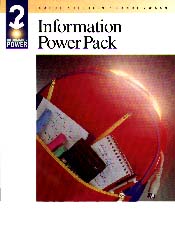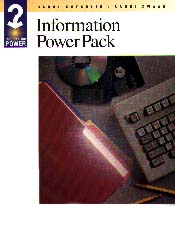|
________________
CM . . . .
Volume V Number 2 . . . . September 18, 1998
My first look at Koechlin and Zwaan's "Information Power" series made me think, "At last, a Canadian resource to help teachers (and teacher-librarians) teach the research process." A quick flip through the three books, however, revealed a lot of repeated materials, and a deeper look revealed even more repetition, disguised by re-formatting. What gives here? The information provided on the versos of the title pages indicates that the skillsbooks are based on two documents that the authors originally created for the Scarborough Board of Education, "Help" for 12-15 year olds and "Connections" for 8-12 year olds. The teacher guide appears to have been a later document, perhaps written to create a series.
The general approach for teaching the research process that is presented in the teacher guide, Teaching Tools for the Information Age, is solid, and there are some materials which could be adapted to specific teaching contexts. For example, Chapter 2 includes guidelines for interviewing and conducting surveys, and Chapter 3 has information on how to read pictures. Chapter 4 has many examples of graphic organizers, and Chapter 5 introduces rubrics as a peer evaluation technique.
The introduction to the teacher guide hits some familiar keys--the knowledge economy, a definition of information literacy, the skills needed for lifelong learning, and the need to integrate information skills instruction into the regular curriculum. A brief discussion of the differences between data, information, knowledge and wisdom is followed by the presentation of a four-stage model of the research process (develop a focus, process data, develop a product, evaluate my learning). Unfortunately, there are no clear connections between the research process model and the seven chapters of Teaching Tools which are organized around "learning expectations." For example, there are ideas in Chapter 6 ("Engage in library and media experiences") that teachers could use to help students to "develop a focus" (e.g., using video to build children's interest in and knowledge of a research topic), but no mention is made of that connection with teaching the research process.
Overall, Teaching Tools promises more than it delivers. For example, the cover suggests that there will be "suggestions for adapting activities to the specific needs of different ages, abilities and learning styles" - not so. For instance, the student self-assessment worksheet on page 53 uses terms such as "conflicting" and "summarized," but there are no suggestions of
appropriate age or ability levels for its use, nor are there suggestions for adapting it for other ages or abilities. The cover also states that the guide will show teachers how to help students "assume responsibility for their own learning" and "facilitate self-, peer and group evaluation." One approach to meeting these goals is the development and use of rubrics. The presentation rubric on page 78 is a useful sample, but there is no mention of the process that the teacher would follow for developing such a rubric, let alone any suggestion that students could or should be engaged in developing rubrics. On page 9 of Teaching Tools, the authors state that "Evaluation (Stage 7) is ongoing throughout the process." However, in Chapter 7 there is no explanation or follow-up for this concept that would help readers understand the need for ongoing evaluation as a way to develop students' metacognitive strategies, that is, as a way to help students to think about their own learning processes and to monitor, evaluate and regulate their own thinking. This is an example (and there are many more) of the lack of attention given in Teaching Tools to the theory base for the process approach to research. Another significant omission is that of a few sample research projects to show how the whole process works.
All the books in this series follow the same format, use the same basic chapter headings, and contain much of the same materials. The skillsbooks for students - workbooks with a new name - represent an approach that is inconsistent with teaching the research process in a meaningful way and with the development of independent learners. It is hard to imagine students working their way through their skillsbooks, with or without their teachers, as they conduct any kind of authentic research task. If you purchase any of these, buy the teacher guide, Teaching Tools for the Information Age, only.
Dianne Oberg teaches the research process as part of her work in teacher and teacher-librarian education at the University of Alberta.
To comment on this title or this review, send mail to cm@mts.net.
Copyright © the Manitoba Library Association.
Reproduction for personal use is permitted only if this copyright notice
is maintained. Any other reproduction is prohibited without
permission.
Published by
TABLE OF CONTENTS FOR THIS ISSUE - SEPTEMBER 18, 1998.
AUTHORS |
TITLES |
MEDIA REVIEWS |
PROFILES |
BACK ISSUES |
SEARCH |
ORDER |
CMARCHIVE |
HOME
|



